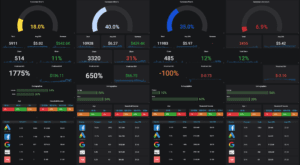In the land of mar-tech solutions, a key missing element for most companies in their mar-tech stack is a marketing dashboard. Marketing dashboards can aggregated data across multiple marketing solutions and then analyze the information to find out what’s working and what’s not.
Understand the REAL CPA/ROI of your campaigns: When using tools such as Google Analytics, it’s often difficult and expensive to import data from other ad platforms. It’s also very easy to get this wrong. Problems such as someone refreshing a page or clicking a back button can cause your leads and conversions to be reported as double or triple what the real number is, completely skewing the real results. Most companies set a number for the ‘value’ if the lead, but it doesn’t accurately represent the value of a lead. By getting the REAL numbers, you can clearly see what the value of the lead is and use this to adjust your marketing strategy accordingly.
Identify which campaigns work (and which ones don’t): Many companies ‘Set it and Forget It’ with their marketing campaigns. They turn on an ad, use the default values (getting traffic from poor sources), then wonder why they aren’t getting leads. SEO experts report that many companies are flat out wasting between 50-90% of their adwords budget. By measuring what’s working, you have more insights to turn off what’s not working.
Faster Experimentation: Everything about creating ads is ultimately an experiment – move this keyword to a new campaign, remove these keywords driving poor traffic. By tracking these changes over time, you can clearly see the results in a shorter timeframe and reduce your marketing spend on ads that aren’t converting.
Respond faster when something changes: If you’ve had a campaign that was performing well, then suddenly the cost per click rose because new competitors started bidding up the keywords, well it can often take weeks to see those results and do something about it. By measuring campaign spend and leads on a day-by-day basis, you can see clear patterns and trends and can quickly identify a campaign that isn’t working anymore.
Measure ROI across Platforms/Channels/Campaigns: Many companies manage their ad spend and management across several platforms. Log into Google Ads to see those results, log into Facebook to see those results, log into Bing to see those results. Then rinse and repeat. Aggregating data into a single platform makes it easy to see if the same campaign performs differently on different ad platforms – even if the copy is exactly the same. You can maximize your ROI by understanding which platforms are bringing you the best customers.
Identify segments that perform best: Once you have a handle on what campaigns are working, another step you can take a look at defining segments and identifying what segments have the highest CLV. From there you can take your marketing to the next level to identify which campaigns are best targeting those segments and get rid of campaigns that drive traffic from low-valued segments.
Identify the strategies that perform best: Among the 19 different traction tools identified in Gabriel Wienberg’s book Traction (a great summary of these are here https://medium.com/@yegg/the-19-channels-you-can-use-to-get-traction-93c762d19339), it’s often hard to find which ones actually work. Email marketing companies like to say that the cost of conversion of email is the lowest out of any marketing channel, however they forget the cost of getting that email into your database. By aggregating and measuring across all channels, you can clearly see what strategies work and which ones don’t.
Understanding the Real Customer Journey: Often the customer journey is a varied one with multiple paths to make a decision. They may come to your site, check out a few pages and leave, then see your ad in a retargeting campaign and subscribe, then don’t look at any of your email drip campaigns, but do respond to a direct sales request sent by a person. All of this information is measurable and trackable and almost noone is doing this. This level of insights help you understand what interactions drive conversions and sales.
Identify what content converts: Everyone loves to talk about how inbound marketing is the answer, however, the realities of inbound marketing is that it takes a lot of work. Just listing an article doesn’t necessarily get you listed in any relevant ranking on SEO and just pushing out a link on your Twitter or LinkedIn feed doesn’t necessarily drive sales to your site. By analyzing the content viewed by customers and which lead sources they came in on, you can clearly see what type of content you should be publishing to create more inbound leads.








